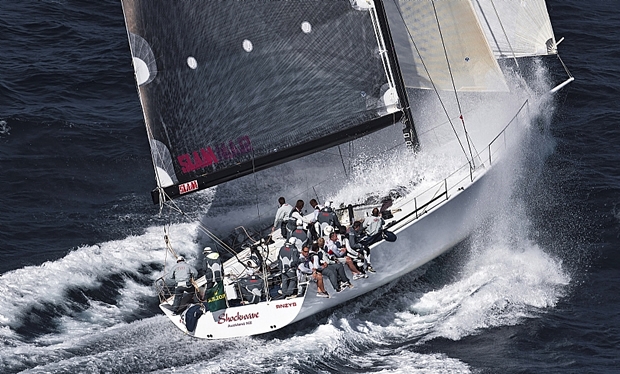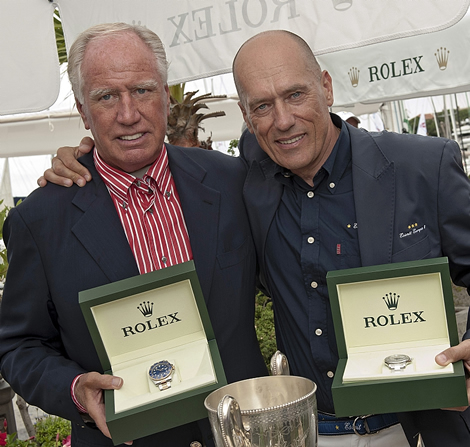
Overall victory for Shockwave
In previous editions, Neville Crichton Zealand has committed his best efforts to winning line honours and breaking the course record. At this year’s Giraglia Rolex Cup, Crichton made it clear that his intentions were the overall win in the distance race. That he achieved this aim at his first true attempt and so convincingly has impressed even this serial collector of race trophies. The 72ft Shockwave (NZL) finished the 241 nautical mile race in second place on the water, just over an hour after Esimit Europa 2. This was impressive enough. More significantly, though, Crichton’s Reichel-Pugh designed Mini Maxi beat Udo Schutz’ STP 65 Container (GER) by 42 minutes on handicap to claim the top prize.
Crichton’s assessment of his team’s mission ahead of the start of the distance race was prescient: “"e’ve always got line honours in the past, I don’t think we’ll be so successful this time. There’s no way we can beat the 100-footer [Esimit] over the line. Shockwave is totally handicap-oriented and I think we’ve got a good crack at the handicap win, and, a good crack at coming second [on the water].”
One crack later and the biggest ripples on the water were plainly from Shockwave. “I’m ecstatic. We set out to win on handicap and to do so is just great. When I left San Remo this morning I had no idea we might win," said Crichton continuing, "we drove the hell out of the boat on the way to the rock, consistently doing 22 knots. We had the bow under the water a lot of the time and it was uncomfortable, but we were keeping up with the 100-footer most of the way across which was impressive. About 30 miles short of the rock, the 100-footer started to pull away. We slowed up and I thought that was that.” Plainly, it was not.

Shockwave’s race of mixed fortunes ended at 12.15 yesterday (Thursday). At the start on Wednesday, Crichton’s crew with three-time Volvo Ocean Race winner Stuart Bannatyne in the tactician’s role had been quick off the start. Not as quick as the nimble footed Jethou (GBR), which reached the initial windward mark in first place by a hair’s breadth. Jethou’s glory was short-lived with the New Zealanders passing her before La Moutte, the turning mark at the mouth of the Bay of Saint-Tropez. Shockwave, in turn, was overtaken by the fastest boat in the fleet, Esimit (formerly Crichton’s Alfa Romeo II), as the fleet headed to La Fourmigue, the final mark before the turn to the Giraglia.
The leg from La Fourmigue to the mythical rock was a drag race for the bigger yachts. Benefiting from the 20 knot breeze from the southwest, the frontrunners barrelled down the track in, frankly, awesome conditions. Igor Simcic, owner of Esimit, was in raptures at the finish not just about securing line honours, but particularly this early segment of the race: “£e were really flying to the Giraglia, at times making 27 knots. That is really special. With this boat it is really something fantastic. It is difficult to describe the sensation; the boat is flying. All the time I was thinking this is incredible…just incredible.”
As with all drag races the parachute eventually had to be deployed and the brakes applied. Just before sunset and shy of the Giraglia, the wind dropped and the fleet slowed dramatically. From then on the race became a struggle for everyone, as the pressure went up and down. Miguel Bonet, the skipper of the Farr 52 Plis-Play, confirmed the difficulties: “Initially we had good wind on the way the rock, but eventually it took us 15 – 16 hours to get there at 8 in the morning. Then the wind was really down and we were stopped for three or four hours until the wind came up again. Even at the finish the wind was very fine and difficult”.
When the Swan 90 Solleone rounded the rock at 07.30 she had been fortunate and encountered solid breeze and set off on a fast fetch towards San Remo. Like those on the yachts nearest to her, the crew assumed that the frontrunners were experiencing the same and must have been about to finish, close to the course record.
This assumption was unfounded. The Ligurian Sea between the Giraglia and San Remo was not in the friendliest of moods. What it had given on the first day it well and truly took away on the second. Where the first day was beautiful the second day was ugly. It took considerable patience and determined perseverance to stay the course – as evidenced by the number of retirees, fed up with the trickeries and twisted imagination of the Giraglia wind gods that did their best to frustrate the crews. Those that finished the race knew they had been set and had completed a Herculean task, a mind game that could test even the most professional crews.
On Esimit the primary concern in the mind of Favini, who has participated in several Giraglia Rolex Cups before, was that every time the blue flyer parked up the breeze would fill from behind and favour the slower boats: “When you stop, normally the fleet catches up. It is very easy to get caught, but you know that the others probably have had the same problem. They [Shockwave] definitely gained on us since they finished so close, I think we may have had more light air than them.” Whether his assessment was correct or not, what applied to Esimit, almost certainly applied to Shockwave and so on through the fleet. No one had a straightforward ride from the rock, physically or mentally.
Prior to the off, Bannatyne had hedged his bets after describing the perfect scenario being played out on the weather models, all of which were happily predicting good winds for much of the race. “It all sounds very nice and simple, but whether it turns out that way we’ll just have to wait and see,” said the man who has done it and seen it all before.
It was not simple at all. Crichton confessed that the worst moment of the race for Shockwave had been halfway between the rock and the finish, when “we parked for 3…3.5 hours midway across. I thought that would damage us a lot. We had opened a big lead on Container after rounding the rock, but watched her pull up on us. We then parked up again just off the coast at San Remo and could see Esimit just ahead, but for the park-ups. We might have finished closer to her than we did.”
For Crichton, though, the twists and turns of the race are long forgotten. Understandably, he is beyond worrying about what might have been; his delight is manifest, so much so that he has changed his travel plans to attend the prize giving tomorrow. There is only ever one overall winner and this year it is he and his crew that is taking home the main prize.
The prizegiving for 2010 Giraglia Rolex Cup will be held at 13.00 CEST on Saturday, 19 June at the Yacht Club San Remo.









Latest Comments
Add a comment - Members log in